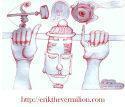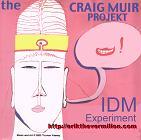Be Kind! Share with your Team, with your Family, with your Buddies!
Click The Button Now & Like This On Your Facebook Page!
Friday, July 06, 2012
Know The Story Of Wrist Watches
The Egyptians were the first individuals to develop extensively a means of telling time with calendars and clocks. By around 2800 BC they had established a 365-day calendar, based on their observations from the rising and setting of vibrant stars such as Sirius and from the periodic inundations from the Nile, upon which their agriculture relied. By 2100 BC the Egyptians had devised a method to divide the day into 24 hours. About the same time, they made the first sundials, or shadow clocks, to measure time during the day. A sundial indicates the time of day by the position from the shadow of some object on which the sun's rays fall.
Babylonian astronomers' fine tuned the clepsydra taking into account the equation of time brought on by the varying distance between the Earth and also the sun because it moves in an elliptical orbit. Due to this effect, noon might be as much as a half hour before or after the time when the sun is highest in the sky.
Measurement of short time intervals, however, was possible with the hourglass. The search for accurate clocks started with the burgeoning late medieval commerce and also the initial fruits from the scientific revolution. This require lead to the mechanical clocks which measured time with easy weighted pendulums. But these were not portable.
The invention of springs and escapement mechanism ushered in the era of portable Replica Breitling watches. The escapement is really a mechanism that controls and limits the unwinding from the watch, converting what would otherwise be a easy unwinding, into a controlled and periodic power release. The escapement does this by interlocking having a gear in a easy manner that switches between a "driven" and a "free" state, with abrupt locking at every end from the cycle. The escapement also for the same cause produces the ticking noise characteristic of mechanical watches.
Another mechanical technique will be the balance wheel mechanism. The balance wheel with each other with the balance spring (also known as Hairspring) - these form a easy harmonic oscillator, which controls the motion from the gear system from the watch in a manner analogous to the pendulum of a pendulum clock. This really is possible since the moment of inertia from the balance wheel is fixed, and also the wheel as a entire provides a regular motion of known period. These watches produce a ticking sound.
Purely mechanical watches are nonetheless popular. The high degree of craftsmanship of purely mechanical watches accounts for much of their attraction. Compared to electronic movements, mechanical watches are inaccurate, often with errors of seconds per day. They're frequently sensitive to position and temperature, they are costly to produce, they need regular maintenance and adjustment, and they are more prone to failure.
Additional accuracy was accomplished in the sixties by Tuning fork watches, which use a tuning fork at a precise frequency (most often 360 hertz) to drive a Panerai Radiomir mechanical watch. Since the fork is utilized in place of a typical balance wheel, these watches naturally hum rather than tick. Tuning fork movements are electromechanical. The job of converting electronically pulsed fork vibration into rotary movement is done through two tiny jeweled fingers, called pawls, 1 of which is connected to 1 from the tuning fork's tines. Because the fork vibrates. This index wheel has more than 300 barely visible teeth and spins greater than 38 million times per year. The tiny electric coils that drive the tuning fork have 8000 turns of insulated copper wire having a diameter of 0.015 mm and a length of 90 meters. This incredible feat of engineering was prototyped in the 1950s and also the early 60's.
In 1948, Max Hetzel utilized an electronic device, a transistor to make the first electronic watch. This development became obsolete with the use of a quartz crystal which brought in the quartz watches, which use the piezoelectric effect in a tiny quartz crystal to offer a stable time base for a mostly electronic movement: the crystal types a quartz oscillator which resonates at a specific and highly stable frequency, and which may be utilized to accurately pace a timekeeping mechanism. These mainly electronic movements are geared to drive mechanical hands on the face from the watch. Quartz movements are ten times much better than a mechanical movement.















